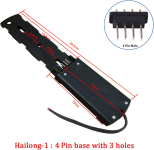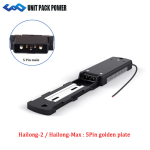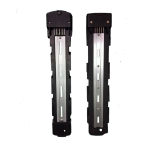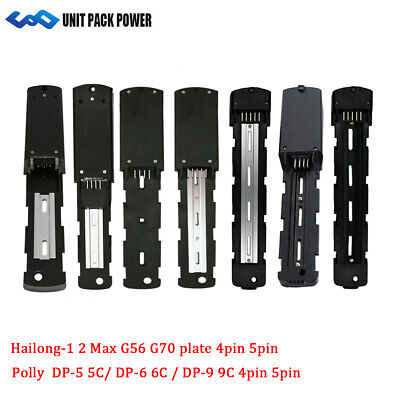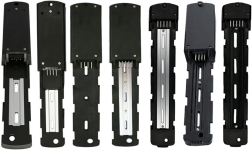The below is applicable to ANY battery you want to by and use:
First...is the seller highly rated, and is there a good amount of long term feedback on the batteries they sell? If not, you might consider a different seller that is. Batteries are the heart of any system, and if they're not good the system wont' do what it should. They can also be dangerous if poorly built or made of junk, both of which are true for MANY batteries out there, some of which "look" ok, but are not. True especially for "cheap" batteries. Most sellers dont' even know anything about what they sell, which you can find out pretty quickly by asking some pointed questions about the technical aspects of their packs contents and construction (which you should do for any battery you want to buy even one of, much less many of). Also...do the batteries meet the needs of the system you want to build? Can they supply the necessary power for the full amount of time you need them to, under your specific riding conditions, and do they have the capacity to do this for the distance you need to go?
Next: Are they using one of the common 3rd party casings, or something custom to that bike? If it's custom to that bike (like something built into the frame, etc) you'll have to get hold of Nakto for the parts, or get hold of a bike they fit on and copy the design (3d print one, etc). (unless that seller also sells cradles for them...and if they don't, ask them why they don't, and if they know who does).
With anything like this, unless you can just contact the company making the stuff (or making the thing the stuff is meant to go on, like in this case) to buy some, you're going to have to do googling (or your favorite search engine), or manually look at all the places ebike parts are sold (which is nearly everywhere) and just look at each individual thing that is out there and see if it fits the other thing you want to buy...or you'll have to make a solution, or adapt one that is out there.
For instance, it took me about a minute and a half with google to locate the ebay link to the cradles / adapters for the Hailong packs I posted earlier in the thread.

Some things take a lot more work to find, because they aren't that common, and some things just don't exist yet...but something close does, that can be modified. I haven't looked for Nakto stuff, but if it's out there, you could find it.

As long as the cell block inside is already configured in a physical layout that will drop into the case you want to use, it's easy. If it is not, then you could be looking at significant expensive work and tools, with risk of damage to cells (and potentially fire) if something goes wrong with a reconfiguration.
So the simplest way to re-case one is to pick a case that works with the layout, and use that, or to just skip using those and find a pack that you don't have to re-case, or that will fit in the case you want to use.
Remember a used battery is a complete unknown, and worth zero dollars until it is proven to be capable of whatever you need it to do.

The rest of the kit is probably perfectly fine (except maybe the wheel build***), but a battery is rarely cared for, and by the time most people get around to selling their old layabout stuff, it has sat uncharged and untested for many months or even years, and the BMS has probably at best made a serious imbalance in the cells by draining some to power itself from, or worse drained them dead to unsafe-to-recharge levels (some BMS run off the whole pack, so it takes longer but it kills *all* the cells when it happens, instead of the first few most negative ones).
Also...many (most) kits are very cheap, and regardless of the hundreds of dollars or more that they are being sold for are the same stuff being sold by places like Voilamart for a couple hundred bucks.
About the only expensive ones I usually see that might be worth the prices being charged for them are the RTR kits at ebikes.ca.
There's several threads about replacing the locks on cases or cradles around here somewhere that will probably help with that.
***wheels from most of these cheap kits are built with spokes too thick for the rims they used, so they have to be tensioned higher than the rim can handle, and then they damage the rim, deforming or cracking it around the nipple holes, loosening the spokes, which then begin to fail. (the process happens faster when someone that hasn't examined the rim and doesn't know how wheels work tries to fix it by tightening the loose spokes, which further damages the rim and still leaves a loose spoke, etc.). Why do they use the wrong spokes? Because that's how the industry started, and bigger numbers always mean better, right? So a thicker spoke *must* be better! But it isn't...and marketing departments, etc., will never be convinced of that, especially since they don't actually care if the stuff they make actually keeps working for the customer--if it breaks the customer has to buy more, so.... very few ebike motor wheel builders use the right spokes for the rims they use. (and the spokes and rims they use are usually, like the rest of what they build with, the cheapest things they could possibly get hold of).
So having to relace the wheels in your case is actually very likely a good thing--you have the chance to use the correct smaller spokes (14-15g butted) instead of the too-thick spokes usually used (12g straight) for your rims. (you *can* use those thicker spokes, but your rim has to be designed for the tension they will require, and most bicycle rims are not).



